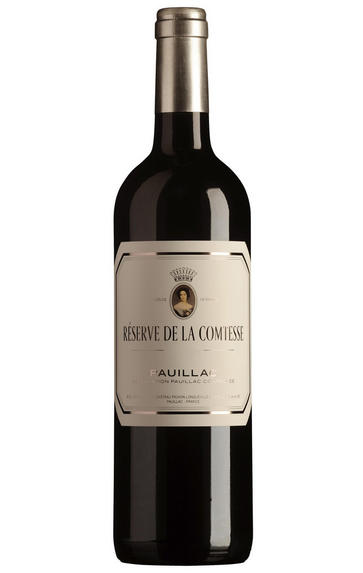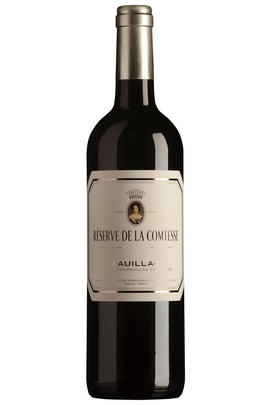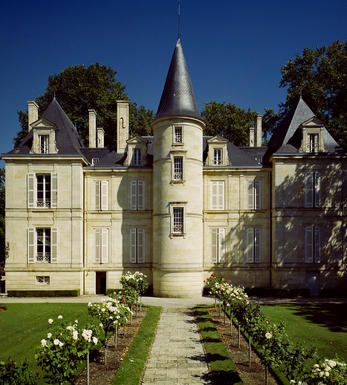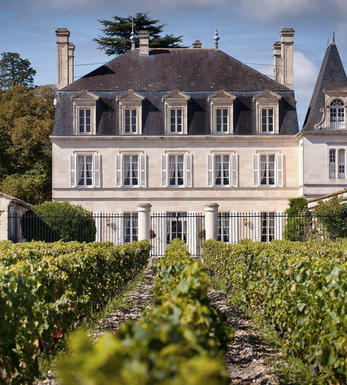
2014 Réserve de la Comtesse, Pauillac, Bordeaux

Critics reviews
Neal Martin - 31/03/2017
Jancis Robinson MW - jancisrobinson.com - Mar 2015
About this WINE

Château Pichon Comtesse
Château Pichon Comtesse is an estate in Pauillac on the Left Bank of Bordeaux. The estate was ranked a Second Growth in Bordeaux’s 1855 classification, and belongs to an unofficial group referred to as “Super Seconds”.
It is located in the southern part of the Pauillac appellation, just next to Château Latour and a short distance from the border with St Julien. The attractive château building here is visible from the D2 road as you approach Pauillac from the south, on the opposite side of the street from Château Pichon Baron. The two neighbours were once part of one larger estate, which was divided in two in 1850. From 1978 until the mid-2000s, Pichon Comtesse was managed by Madame May-Eliane de Lencquesaing, one of the most prominent women in Bordeaux history.
Today, the estate belongs to the Rouzaud family, owners of Champagne Louis Roederer. The estate, which currently has 80 hectares of vines, is managed by talented winemaker Nicolas Glumineau. Nicolas and his team also manage Château de Pez, a sibling estate further north in St Estèphe.

Pauillac
Pauillac is the aristocrat of the Médoc boasting boasting 75 percent of the region’s First Growths and with Grand Cru Classés representing 84 percent of Pauillac's production.
For a small town, surrounded by so many familiar and regal names, Pauillac imparts a slightly seedy impression. There are no grand hotels or restaurants – with the honourable exception of the establishments owned by Jean-Michel Cazes – rather a small port and yacht harbour, and a dominant petrochemical plant.
Yet outside the town, , there is arguably the greatest concentration of fabulous vineyards throughout all Bordeaux, including three of the five First Growths. Bordering St Estèphe to the north and St Julien to the south, Pauillac has fine, deep gravel soils with important iron and marl deposits, and a subtle, softly-rolling landscape, cut by a series of small streams running into the Gironde. The vineyards are located on two gravel-rich plateaux, one to the northwest of the town of Pauillac and the other to the south, with the vines reaching a greater depth than anywhere else in the Médoc.
Pauillac's first growths each have their own unique characteristics; Lafite Rothschild, tucked in the northern part of Pauillac on the St Estèphe border, produces Pauillac's most aromatically complex and subtly-flavoured wine. Mouton Rothschild's vineyards lie on a well-drained gravel ridge and - with its high percentage of Cabernet Sauvignon - can produce (in its best years) Pauillac's most decadently rich, fleshy and exotic wine.
Latour, arguably Bordeaux's most consistent First Growth, is located in southern Pauillac next to St Julien. Its soil is gravel-rich with superb drainage, and Latour's vines penetrate as far as five metres into the soil. It produces perhaps the most long-lived wines of the Médoc.
Recommended Châteaux
Ch. Lafite-Rothschild, Ch. Latour, Ch. Mouton-Rothschild, Ch. Pichon-Longueville Baron, Ch. Pichon Longueville Comtesse de Lalande, Ch. Lynch-Bages, Ch. Grand-Puy-Lacoste, Ch, Pontet-Canet, Les Forts de Latour, Ch. Haut-Batailley, Ch. Batailley, Ch. Haut-Bages Libéral.

Cabernet Sauvignon Blend
Cabernet Sauvignon lends itself particularly well in blends with Merlot. This is actually the archetypal Bordeaux blend, though in different proportions in the sub-regions and sometimes topped up with Cabernet Franc, Malbec, and Petit Verdot.
In the Médoc and Graves the percentage of Cabernet Sauvignon in the blend can range from 95% (Mouton-Rothschild) to as low as 40%. It is particularly suited to the dry, warm, free- draining, gravel-rich soils and is responsible for the redolent cassis characteristics as well as the depth of colour, tannic structure and pronounced acidity of Médoc wines. However 100% Cabernet Sauvignon wines can be slightly hollow-tasting in the middle palate and Merlot with its generous, fleshy fruit flavours acts as a perfect foil by filling in this cavity.
In St-Emilion and Pomerol, the blends are Merlot dominated as Cabernet Sauvignon can struggle to ripen there - when it is included, it adds structure and body to the wine. Sassicaia is the most famous Bordeaux blend in Italy and has spawned many imitations, whereby the blend is now firmly established in the New World and particularly in California and Australia.


Buying options
Add to wishlist
Description
What a beautiful opening to this, with stunning cassis fruit and just a touch of wood spice that adds complexity. The palate is graceful and fresh, with the cherry fruit emerging again with liquorice and a lovely peppery finish. This is the best Comtesse I have tried for some years and will be an absolute joy to drink in 5-8 years time. I suspect given its fine balance it will drink for 10+ years.
Matthew Tipping - Fine Wine Sales Manager
wine at a glance
Delivery and quality guarantee